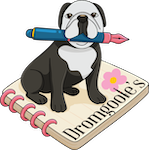Most people know TWSBI for their ever-expanding line of fountain pens, but did you know they make ballpoint pens and mechanical pencils too? I found it to be an interesting decision when TWSBI first introduced these items, but as I have come to expect from them they have created a high quality, fairly priced product.
The model I received for review from JetPens is the TWSBI Precision Mechanical Pencil 0.5 mm with retractable tip. It is a full metal body pencil with a nice knurled-style grip, and a tip that retracts when pressing down on it and clicking the mechanism. It's a nice feature, although not one that is make or break for me personally. What is interesting though is that the retractable tip models are the exact same price ($25) as the fixed tip models. That is not something you see from other vendors. The retractable tip usually costs a premium.
Writing with the Precision is a nice experience. It is well balanced, the knurling is tame, and the provided lead of unknown origin is smooth, dark, and not too soft. The eraser is one of the niceset I have used on a mechanical pencil, removing all traces of graphite easily and cleanly. And it is extra long, so it is far more useful than it's competition. TWSBI also ships extra leads and erasers with the pencil, which is a great bonus.
If you are a mechanical pencil fan, the comparisons to the Rotring 600 are inevitable. The TWSBI Precision is less expensive and has the added retractable tip option, but the Rotring 600 is widely considered to be one of the best drafting pencils ever made. There is something about its feel that is solid and dense, yet its light enough to allow you to glide across the page without knowing the pencil is there.
So yes, gun to my head I take the Rotring 600 over the TWSBI Precision, but that's just me. The TWSBI is excellent in its own right, and fits in nicely with its competition in this price range. I look forward to seeing what else TWSBI has up their sleeve in the non-fountain pen realm.
(JetPens provided this product at no charge to The Pen Addict for review purposes.)










































